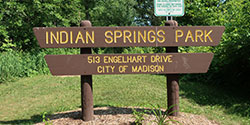Indian Springs Park

| Address: | 513 Englehart Dr. |
| Hours: | 4:00am - 10:00pm |
| Park Type: | Open Space |
| Acres: | 10.84 |
| Restroom: | No |
| Drinking Water: | No |
Park Details
501 Englehart DriveAt this Park
-
 Hiking
Explore the many scenic trails and pathways throughout Madison Parks. Year-round restrooms are available at Cherokee Marsh, North and Owen conservation parks.
Hiking
Explore the many scenic trails and pathways throughout Madison Parks. Year-round restrooms are available at Cherokee Marsh, North and Owen conservation parks.
MAPS
Looking for a trail map for a particular park? A number of the individual park pages provide a trail map. Check out the "About This Park" section of your favorite park. Don't see a map? Let us know!
Dogs
Most parks allow leashed & licensed dogs with a Dog Permit. However, dogs are prohibited in all conservation parks and a few other locations. See Dog Free Parks for more information. View all Hiking -
 Snowshoeing
Snowshoeing
Snowshoeing in Madison Parks
Experience winter in Madison Parks like never before with snowshoeing! This silent sport is a fantastic way to explore many of our parks during the winter months and is easy to learn.
Snowshoe Rentals & Concessions
Snowshoe rentals are available from the staff warming shelter at Elver and Vilas.
SNOWSHOEING TIPSSnowshoe Rentals Price Adult - first hour $5 Youth - age 15 and younger, first hour $3 Each additional hour $2 Adult - daily $25 Adult - each additional day $15 Youth - daily $10 Youth - each additional day $5 - Designated snowshoe trails are offered in the following parks.
- Snowshoeing is allowed anywhere in a general park with good snow cover - typically about 4" or more, except on a marked cross-country ski trail.
- Snowshoeing is allowed in any trail in a conservation park, except Owen, and Turville Point, which are designated ski trails.
- DO NOT snowshoe off-trail in a conservation park.
- Snowshoeing, hiking, and skiing off-trail can destroy snow tunnels used by native small rodents (deer mice, shrews) by the trampling effect. These small mammals are an important part of the wetland and grassland ecology in our conservation parks. Destruction of these tunnel networks makes small mammals more vulnerable to predation.
- When in doubt, it's always best to stay on a trail.
- Our trail systems are designed to facilitate controlled public access while protecting environmentally sensitive areas and providing a quiet refuge for wildlife away from people. Disruption of wildlife by human activity during the winter puts additional stress on them during a challenging time for their survival.



